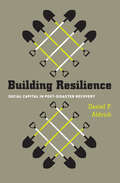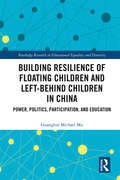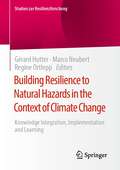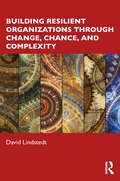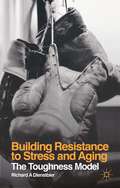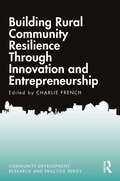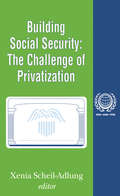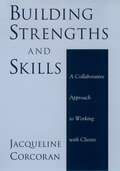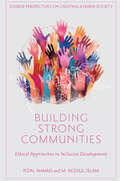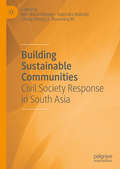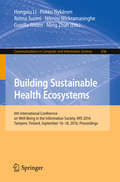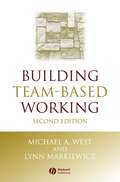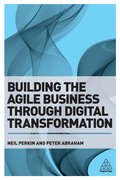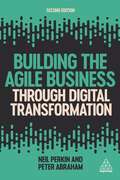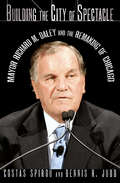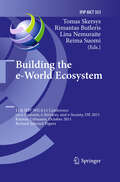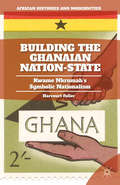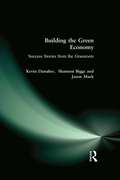- Table View
- List View
Building Resilience: Social Capital in Post-Disaster Recovery
by Daniel P. AldrichEach year, natural disasters threaten the strength and stability of communities worldwide. Yet responses to the challenges of recovery vary greatly and in ways that aren’t explained by the magnitude of the catastrophe or the amount of aid provided by national governments or the international community. The difference between resilience and disrepair, as Daniel P. Aldrich shows, lies in the depth of communities’ social capital. Building Resilience highlights the critical role of social capital in the ability of a community to withstand disaster and rebuild both the infrastructure and the ties that are at the foundation of any community. Aldrich examines the post-disaster responses of four distinct communities—Tokyo following the 1923 earthquake, Kobe after the 1995 earthquake, Tamil Nadu after the 2004 Indian Ocean Tsunami, and New Orleans post-Katrina—and finds that those with robust social networks were better able to coordinate recovery. In addition to quickly disseminating information and financial and physical assistance, communities with an abundance of social capital were able to minimize the migration of people and valuable resources out of the area. With governments increasingly overstretched and natural disasters likely to increase in frequency and intensity, a thorough understanding of what contributes to efficient reconstruction is more important than ever. Building Resilience underscores a critical component of an effective response.
Building Resilience of Floating Children and Left-Behind Children in China: Power, Politics, Participation, and Education (Routledge Research in Educational Equality and Diversity)
by Guanglun Michael MuThe past two decades have seen exponential growth of urbanisation and migration in China. Emerging from this growth is a population of floating and left-behind children which is estimated to be approaching 100 million. Due to their increasing risks of undesirable educational and social, as well as health and psychological, outcomes, there is a great urgency to help floating children and left-behind children beat the odds. This book offers an analysis of how oscillations of government discourse have come to shape central and local educational policies regarding the schooling of these children. It also delves into child and youth resilience in this unique migration context, examining what can be done to build up resilience of floating and left-behind children. In this vein, the book will complement current knowledge and advance context- and culture-specific understandings of child and youth resilience through both school-based and community-based approaches. The book aims to answer a fundamental question: How to help floating children and left-behind children become responsive and resilient to structural deficiencies and dynamics in the migration context of China? This is important reading for scholars, school professionals, community workers, and policy makers to better address the social and educational resilience and wellbeing of floating and left-behind children.
Building Resilience of Floating Children and Left-Behind Children in China: Power, Politics, Participation, and Education (Routledge Research in Educational Equality and Diversity)
by Guanglun Michael MuThe past two decades have seen exponential growth of urbanisation and migration in China. Emerging from this growth is a population of floating and left-behind children which is estimated to be approaching 100 million. Due to their increasing risks of undesirable educational and social, as well as health and psychological, outcomes, there is a great urgency to help floating children and left-behind children beat the odds. This book offers an analysis of how oscillations of government discourse have come to shape central and local educational policies regarding the schooling of these children. It also delves into child and youth resilience in this unique migration context, examining what can be done to build up resilience of floating and left-behind children. In this vein, the book will complement current knowledge and advance context- and culture-specific understandings of child and youth resilience through both school-based and community-based approaches. The book aims to answer a fundamental question: How to help floating children and left-behind children become responsive and resilient to structural deficiencies and dynamics in the migration context of China? This is important reading for scholars, school professionals, community workers, and policy makers to better address the social and educational resilience and wellbeing of floating and left-behind children.
Building Resilience to Natural Hazards in the Context of Climate Change: Knowledge Integration, Implementation and Learning (Studien zur Resilienzforschung)
by Gérard Hutter Marco Neubert Regine OrtleppUrban resilience and building resilience are “hot topics” of research and practice on sustainability in the context of climate change. The edited volume advances the “state of art” of urban resilience research through focusing on three important processes of building resilience: knowledge integration, implementation, and learning. In the volume, knowledge integration primarily refers to the combination of specialized knowledge domains (e.g., flood risk management and urban planning). Implementation refers to realized specific changes of the building stock and related green, blue and grey infrastructures at local level (e.g., for dealing with rising temperatures and heat waves at the neighborhood scale in cities). Learning requires moving beyond single projects and experiments of resilience to enhance sustainability at city and regional scale. The editors adopt an interdisciplinary approach to this volume of the Springer series on resilience. The volume includes contributions from civil engineering, physical geography, the social sciences, and urban planning.
Building Resilient Organizations through Change, Chance, and Complexity
by David LindstedtA must-read in the wake of COVID-19, this book unpacks the nature of resilient organizations and how they prepare for unpredictable, complex, and profound change. Organizations that do not adapt and evolve die. To date, however, it has not been at all clear how to build a resilient organization. That puts us all in the unenviable position of trying to ready our organizations for an increasingly uncertain future without the proper guidance to do it. This book introduces 14 elements of resilience that consistently emerge in organizations that have thrived amid adversity and volatility. Resilience is not about determination, grit, cybersecurity, or teams of resilient individuals; resilience, it turns out, is often confused with robustness. Readers will discover how resilient organizations build and employ a distinctive combination of crews, capital, culture, and leadership—and, crucially—how to adapt these combinations for their own organization. Senior business leaders, consultants, entrepreneurs, students, and professionals will appreciate this book’s practical, approachable, and engaging guidance, including insights by leaders from Health Care for the Homeless, The Ohio State University, NBCUniversal, retail stores, and more.
Building Resilient Organizations through Change, Chance, and Complexity
by David LindstedtA must-read in the wake of COVID-19, this book unpacks the nature of resilient organizations and how they prepare for unpredictable, complex, and profound change. Organizations that do not adapt and evolve die. To date, however, it has not been at all clear how to build a resilient organization. That puts us all in the unenviable position of trying to ready our organizations for an increasingly uncertain future without the proper guidance to do it. This book introduces 14 elements of resilience that consistently emerge in organizations that have thrived amid adversity and volatility. Resilience is not about determination, grit, cybersecurity, or teams of resilient individuals; resilience, it turns out, is often confused with robustness. Readers will discover how resilient organizations build and employ a distinctive combination of crews, capital, culture, and leadership—and, crucially—how to adapt these combinations for their own organization. Senior business leaders, consultants, entrepreneurs, students, and professionals will appreciate this book’s practical, approachable, and engaging guidance, including insights by leaders from Health Care for the Homeless, The Ohio State University, NBCUniversal, retail stores, and more.
Building Resistance to Stress and Aging: The Toughness Model
by R. DienstbierThe toughness model proposed in this book incorporates psychological research and neuroscience to explain how a variety of toughening activities - ranging from confronting mental and physical challenges to meditation - sustain our brains and bodies, and ultimately build our mental and psychological capacities degenerated by stress and by aging.
Building Rural Community Resilience Through Innovation and Entrepreneurship (ISSN)
by Charlie FrenchDrawing from empirical analyses, case studies, and a synthesis of best practices, this book explores how innovation manifests itself in rural places and how it contributes to entrepreneurial development and resilience. Innovation in rural places may come about as a result of new forms of collaboration; policies that leverage rural assets and address critical service or product gaps; novel strategies for accessing financial capital; infusion of arts into aspects of community life; and cultivation of networks that bridge entrepreneurs, organizations, and institutions. The chapters illustrate how a number of innovation-related characteristics relate to economic vibrancy in rural places such as a strong connection to the arts, adaptive and sustainable use of natural resources, value-chain integrated food systems, robust bridging social capital networks, creative leveraging of technology, and presence of innovation-focused entrepreneurs. Through exploration of these and other topics, this book will provide insights and best practices for rural community and economic development scholars and practitioners seeking to strengthen the rural innovation ecosystem.
Building Rural Community Resilience Through Innovation and Entrepreneurship (ISSN)
by Charlie FrenchDrawing from empirical analyses, case studies, and a synthesis of best practices, this book explores how innovation manifests itself in rural places and how it contributes to entrepreneurial development and resilience. Innovation in rural places may come about as a result of new forms of collaboration; policies that leverage rural assets and address critical service or product gaps; novel strategies for accessing financial capital; infusion of arts into aspects of community life; and cultivation of networks that bridge entrepreneurs, organizations, and institutions. The chapters illustrate how a number of innovation-related characteristics relate to economic vibrancy in rural places such as a strong connection to the arts, adaptive and sustainable use of natural resources, value-chain integrated food systems, robust bridging social capital networks, creative leveraging of technology, and presence of innovation-focused entrepreneurs. Through exploration of these and other topics, this book will provide insights and best practices for rural community and economic development scholars and practitioners seeking to strengthen the rural innovation ecosystem.
Building Social Security: Volume 6, The Challenge of Privatization (International Social Security Ser. #Vol. 6)
by Xenia Scheil-AdlungIn recent years, in both the specialist press and the tabloids, the idea of privatization of social security has become a shimmering catch phrase. Politicians base election campaigns on promises of more or less privatization in social security. Many governments introduce private business management methods into their social security systems. Representatives of social security institutions and academics prepare theory papers on the possible outcomes of privatization. And international financial organizations describe doomsday scenarios based on the premise of failure to privatize.What is the role of privatization today in the development of national social security systems? How does privatization concern the developments in different social security programs such as old age, sickness, unemployment, accident insurance and family allowances? What are the visions and effects of privatization in social security?This volume provides an overview of the various positions of supporters and opponents of privatization in the main branches of social security, followed by national experience of privatized or part-privatized social security systems. While the perspective of each of the contributors is markedly different, the overall objective cuts across differences: namely, to develop the most efficient and cost-effective system of social security protection.The authors' views and knowledge are derived from their firsthand experiences with social security in Africa, Asia, the Americas and Europe. Representatives of the leading international organizations dealing with social security issues-the International Labour Organization, the OECD, the World Bank and the World Health Organization-further expand the parameters of the viewpoints and experiences expressed.This multifaceted book allows the reader to learn about the challenge of privatization in the various forms of social security by assembling a set of highly up-to-date, technically complex and legal issues based on practical analysis and actual experience. It will be of interest to those concerned with national social policy in a comparative context. This is the sixth volume in an ongoing series that aims to review social security in a comparative, global context. Xenia Scheil-Adlung is program manager, International Social Security Association, Geneva, Switzerland.
Building Social Security: Volume 6, The Challenge of Privatization
by Xenia Scheil-AdlungIn recent years, in both the specialist press and the tabloids, the idea of privatization of social security has become a shimmering catch phrase. Politicians base election campaigns on promises of more or less privatization in social security. Many governments introduce private business management methods into their social security systems. Representatives of social security institutions and academics prepare theory papers on the possible outcomes of privatization. And international financial organizations describe doomsday scenarios based on the premise of failure to privatize.What is the role of privatization today in the development of national social security systems? How does privatization concern the developments in different social security programs such as old age, sickness, unemployment, accident insurance and family allowances? What are the visions and effects of privatization in social security?This volume provides an overview of the various positions of supporters and opponents of privatization in the main branches of social security, followed by national experience of privatized or part-privatized social security systems. While the perspective of each of the contributors is markedly different, the overall objective cuts across differences: namely, to develop the most efficient and cost-effective system of social security protection.The authors' views and knowledge are derived from their firsthand experiences with social security in Africa, Asia, the Americas and Europe. Representatives of the leading international organizations dealing with social security issues-the International Labour Organization, the OECD, the World Bank and the World Health Organization-further expand the parameters of the viewpoints and experiences expressed.This multifaceted book allows the reader to learn about the challenge of privatization in the various forms of social security by assembling a set of highly up-to-date, technically complex and legal issues based on practical analysis and actual experience. It will be of interest to those concerned with national social policy in a comparative context. This is the sixth volume in an ongoing series that aims to review social security in a comparative, global context. Xenia Scheil-Adlung is program manager, International Social Security Association, Geneva, Switzerland.
Building Strengths and Skills: A Collaborative Approach to Working with Clients
by Jacqueline CorcoranThis is a much-needed practice book that demonstrates how helping professionals can emphasize their clients' resilience, strength, and capacities, rather than focusing on pathology or deficits. It offers an integrative practice model for both assessment and intervention that interweaves strengths-based (specifically solution-focused therapy and motivational interviewing) and skills-building (cognitive-behavioral) approaches. In the strengths-and-skills-based model, helping professionals assume that clients possess the necessary capacities to solve their own problems, transforming the therapeutic relationship into a collaboration focused on bolstering motivation and resources for change. When these resources are exhausted or when deficits become a substantial barrier, then practitioner and client work to develop an individualized skills-building plan. A wide range of examples, written by Jacqueline Corcoran with experts from different fields of practice, clearly demonstrate how the model can be applied to individuals and families struggling with behavior problems, depression, substance abuse, anxiety, violence, and abuse, so that both strengths and skills maximize the client's success. This innovative, dynamic resource is a must have for practitioners across the helping, social service, and mental health professions.
Building Strong Communities: Ethical Approaches to Inclusive Development (Diverse Perspectives on Creating a Fairer Society)
by Ifzal Ahmad M. Rezaul IslamExploring ethical approaches to inclusive development, Building Strong Communities navigates challenges and strategies, empowering readers to foster resilient, equitable communities in the ever evolving 21st century. Encompassing a wealth of illustrative examples and valuable experiences from different countries around the world, including Canada, Brazil, Sweden, Kenya, China, Australia, Antarctica, India, and more, chapters tackle the mounting necessity for sustainable and equitable development practice. Featuring tools and insights that hold the potential to guide policymakers, practitioners, and scholars alike in the pursuit of nurturing resilient and thriving communities, authors Ifzal Ahmad and M. Rezaul Islam focus on the importance of ethics and inclusivity, offering an interdisciplinary approach, practical frameworks, and impact-driven recommendations for creating thriving communities on a global scale. Illuminating the dynamic interplay between theory and practice, the inclusion of global perspectives showcases the diverse contexts and unique challenges faced by communities around the world, enriching an understanding of community development’s complex landscape. Transcending disciplinary silos and fostering a more comprehensive understanding of community development, Building Strong Communities empowers readers to draw upon multiple perspectives and tools to create meaningful and sustainable change in diverse community contexts and develop holistic solutions that address the interrelated social, economic, environmental, and cultural aspects of community well-being.
Building Strong Communities: Ethical Approaches to Inclusive Development (Diverse Perspectives on Creating a Fairer Society)
by Ifzal Ahmad M. Rezaul IslamExploring ethical approaches to inclusive development, Building Strong Communities navigates challenges and strategies, empowering readers to foster resilient, equitable communities in the ever evolving 21st century. Encompassing a wealth of illustrative examples and valuable experiences from different countries around the world, including Canada, Brazil, Sweden, Kenya, China, Australia, Antarctica, India, and more, chapters tackle the mounting necessity for sustainable and equitable development practice. Featuring tools and insights that hold the potential to guide policymakers, practitioners, and scholars alike in the pursuit of nurturing resilient and thriving communities, authors Ifzal Ahmad and M. Rezaul Islam focus on the importance of ethics and inclusivity, offering an interdisciplinary approach, practical frameworks, and impact-driven recommendations for creating thriving communities on a global scale. Illuminating the dynamic interplay between theory and practice, the inclusion of global perspectives showcases the diverse contexts and unique challenges faced by communities around the world, enriching an understanding of community development’s complex landscape. Transcending disciplinary silos and fostering a more comprehensive understanding of community development, Building Strong Communities empowers readers to draw upon multiple perspectives and tools to create meaningful and sustainable change in diverse community contexts and develop holistic solutions that address the interrelated social, economic, environmental, and cultural aspects of community well-being.
Building Sustainable Communities: Civil Society Response in South Asia
by Rajendra Baikady Md. Nurul Momen Cheng Sheng Li M. BasavarajThe book aims to explore South Asian third sector – the nonprofit organizations as provider of social services. The book defines social welfare and describe its relationship to social service programmes and individual well-being; understands the social policy development from the problem identification to policy implementation; describes the range of organization of social service agencies that are responsible for providing social welfare programmes; explores the various roles that professional and non- professional helpers provide in the delivery of social welfare and their influence in promoting change in policy development; and understands the umbrella concept of Child welfare, welfare of people with disability and elderly welfare in welfare policy.
Building Sustainable Health Ecosystems: 6th International Conference on Well-Being in the Information Society, WIS 2016, Tampere, Finland, September 16-18, 2016, Proceedings (Communications in Computer and Information Science #636)
by Hongxiu Li Pirkko Nykänen Reima Suomi Nilmini Wickramasinghe Gunilla Widén Ming ZhanThis book constitutes the refereed proceedings of the 6th International Conference on Well-Being in the Information Society, WIS 2016, held in Tampere, Finland, in September 2016. The 21 revised full papers presented were carefully reviewed and selected from 42 submissions. With the core topic "Building Sustainable Health Ecosystems" WIS 2016 focused on innovations and fresh ideas in the cross-section of urban living, information society and health as understood in a wide sense. The papers presented in this volume are organized along the following seven broad topics: 1. Macro level considerations of e-health and welfare, 2.Welfare issues of children, youth, young elderly and seniors, 3. Analytics issues of eHealth and welfare, 4. National/regional initiatives in eHealth and welfare, and 5. Specific topics of eHealth. The papers in these topics span qualitative and quantitative analysis, empirical surveys, case studies as well as conceptual work.
Building Team-Based Working: A Practical Guide to Organizational Transformation (One Stop Training)
by Michael A. West Lynn MarkiewiczThis book gives managers and consultants practical guidance on how to build organizations that are structured around effective teamworking. This text focuses on how to build organizations that are structured around teams. Ideal for managers or consultants who are introducing team-based working into organizations. Examines the psychological and social processes that can facilitate or obstruct successful teamwork. Each chapter contains aims, activities, support materials and tools. Support materials can also be downloaded from an accompanying website. Based on evidence gathered by the authors over 20 years of practical management experience, research in organizations, and consultancy.
Building the Agile Business through Digital Transformation
by Neil Perkin Peter AbrahamBuilding the Agile Business through Digital Transformation is an in-depth look at transforming businesses so they are fit for purpose in a digitally enabled world. It is a guide for all those needing to better understand, implement and lead digital transformation in the workplace. It sets aside traditional thinking and outdated strategies to explain what steps need to be taken for an organization to become truly agile. It addresses how to build organizational velocity and establish iterative working, remove unnecessary process, embed innovation, map strategy to motivation and develop talent to succeed. Building the Agile Business through Digital Transformation provides guidance on how to set the pace and frequency for change and shows how to break old habits and reform the behaviours of a workforce to embed digital transformation, achieve organizational agility and ensure high performance. Full of practical advice, examples and real-life insights from organizational development professionals at the leading edge of digital transformation, this book is an essential guide to building an agile business.
Building the Agile Business through Digital Transformation
by Neil Perkin Peter AbrahamBuilding the Agile Business through Digital Transformation is an in-depth look at transforming businesses so they are fit for purpose in a digitally enabled world. It is a guide for all those needing to better understand, implement and lead digital transformation in the workplace. It sets aside traditional thinking and outdated strategies to explain what steps need to be taken for an organization to become truly agile. It addresses how to build organizational velocity and establish iterative working, remove unnecessary process, embed innovation, map strategy to motivation and develop talent to succeed. Building the Agile Business through Digital Transformation provides guidance on how to set the pace and frequency for change and shows how to break old habits and reform the behaviours of a workforce to embed digital transformation, achieve organizational agility and ensure high performance. Full of practical advice, examples and real-life insights from organizational development professionals at the leading edge of digital transformation, this book is an essential guide to building an agile business.
Building the Agile Business through Digital Transformation
by Neil Perkin Peter AbrahamHow can businesses transform to achieve competitive advantage in a digital-enabled world? How can managers and leaders create a culture that supports lasting change through these transformations?Building the Agile Business through Digital Transformation is an in-depth guide for all those needing to better understand, implement and lead digital transformation in the workplace. It sets aside traditional thinking and outdated strategies to explain what steps need to be taken for an organization to become truly agile, embed innovation and develop talent to succeed.This majorly revised second edition of Building the Agile Business through Digital Transformation contains new material on the culture and mindset challenges of shifting at scale from linear to agile working, and using data effectively in organizational decision-making. Full of practical advice, examples and real-life insights from organizations at the leading edge of digital transformation including AirBnb, Amazon and Google, this book is an essential guide to driving success by becoming an agile and digital native business.
Building the City of Spectacle: Mayor Richard M. Daley and the Remaking of Chicago
by Costas Spirou Dennis R. JuddBy the time he left office on May 16, 2011, Mayor Richard M. Daley had served six terms and more than twenty-two years at the helm of Chicago’s City Hall, making him the longest serving mayor in the city’s history. Richard M. Daley was the son of the legendary machine boss, Mayor Richard J. Daley, who had presided over the city during the post–World War II urban crisis. Richard M. Daley led a period of economic restructuring after that difficult era by building a vibrant tourist economy. Costas Spirou and Dennis R. Judd focus on Richard M. Daley’s role in transforming Chicago’s economy and urban culture.The construction of the "city of spectacle" required that Daley deploy leadership and vision to remake Chicago’s image and physical infrastructure. He gained the resources and political power necessary for supporting an aggressive program of construction that focused on signature projects along the city’s lakefront, including especially Millennium Park, Navy Pier, the Museum Campus, Northerly Island, Soldier Field, and two major expansions of McCormick Place, the city’s convention center. During this period Daley also presided over major residential construction in the Loop and in the surrounding neighborhoods, devoted millions of dollars to beautification efforts across the city, and increased the number of summer festivals and events across Grant Park. As a result of all these initiatives, the number of tourists visiting Chicago skyrocketed during the Daley years.Daley has been harshly criticized in some quarters for building a tourist-oriented economy and infrastructure at the expense of other priorities. Daley left his successor, Rahm Emanuel, with serious issues involving a long-standing pattern of police malfeasance, underfunded and uneven schools, inadequate housing opportunities, and intractable budgetary crises. Nevertheless, Spirou and Judd conclude, because Daley helped transform Chicago into a leading global city with an exceptional urban culture, he also left a positive imprint on the city that will endure for decades to come.
Building the e-World Ecosystem: 11th IFIP WG 6.11 Conference on e-Business, e-Services, and e-Society, I3E 2011, Kaunas, Lithuania, October 12-14, 2011, Revised Selected Papers (IFIP Advances in Information and Communication Technology #353)
by Tomas Skersys Rimantas Butleris Lina Nemuraite Reima SuomiThis book constitutes the thoroughly refereed post-conference proceedings of the 11th IFIP WG 6.11 Conference on e-Business, e-Services and e-Society, I3E 2011, held in Kaunas, Lithuania, in October 2011. The 25 revised papers presented were carefully reviewed and selected from numerous submissions. They are organized in the following topical sections: e-government and e-governance, e-services, digital goods and products, e-business process modeling and re-engineering, innovative e-business models and implementation, e-health and e-education, and innovative e-business models.
Building the Ghanaian Nation-State: Kwame Nkrumah’s Symbolic Nationalism (African Histories and Modernities)
by H. FullerGhana has always held a position of primacy in the African political and historical imagination, due in no small part to the indelible impression left president Kwame Nkrumah. This study examines the symbolic strategies he used to construct the Ghanaian state through currency, stamps, museums, flags, and other public icons.
Building the Green Economy: Success Stories from the Grassroots
by Kevin Danaher Shannon Biggs Jason MarkAfter centuries of economic activity based on extraction, exploitation, and depletion, we now face undeniable environmental threats. New business models that save or restore natural resources are critical. But how can we translate that insight into more sustainable practices?Building the Green Economy shows how community groups, families, and individual citizens have taken action to protect their food and water, clean up their neighborhoods, and strengthen their local economies. Their unlikely victories—over polluters, unresponsive bureaucracies, and unexamined routines—dramatize the opportunities and challenges facing the local green economy movement.Drawing on their extensive experience at Global Exchange and elsewhere, the authors also:Lay out strategies for a more successful green movementDescribe how communities have protected their victories from legal and political challengesProvide key resources for local activistsInclude conversations with Rocky Anderson, Lois Gibbs, Anuradha Mittal, David Morris, Michael Shuman, and other activists and leaders.
Building the Green Economy: Success Stories from the Grassroots
by Kevin Danaher Shannon Biggs Jason MarkAfter centuries of economic activity based on extraction, exploitation, and depletion, we now face undeniable environmental threats. New business models that save or restore natural resources are critical. But how can we translate that insight into more sustainable practices?Building the Green Economy shows how community groups, families, and individual citizens have taken action to protect their food and water, clean up their neighborhoods, and strengthen their local economies. Their unlikely victories—over polluters, unresponsive bureaucracies, and unexamined routines—dramatize the opportunities and challenges facing the local green economy movement.Drawing on their extensive experience at Global Exchange and elsewhere, the authors also:Lay out strategies for a more successful green movementDescribe how communities have protected their victories from legal and political challengesProvide key resources for local activistsInclude conversations with Rocky Anderson, Lois Gibbs, Anuradha Mittal, David Morris, Michael Shuman, and other activists and leaders.
